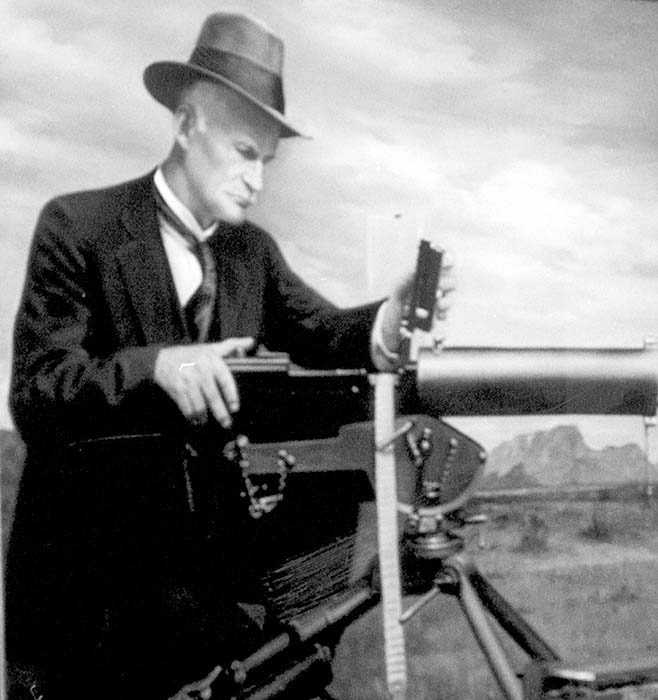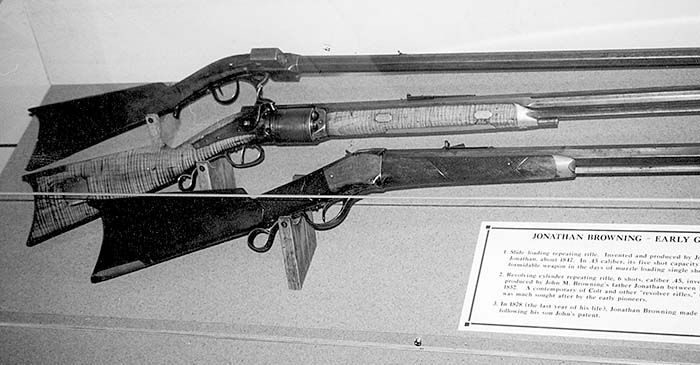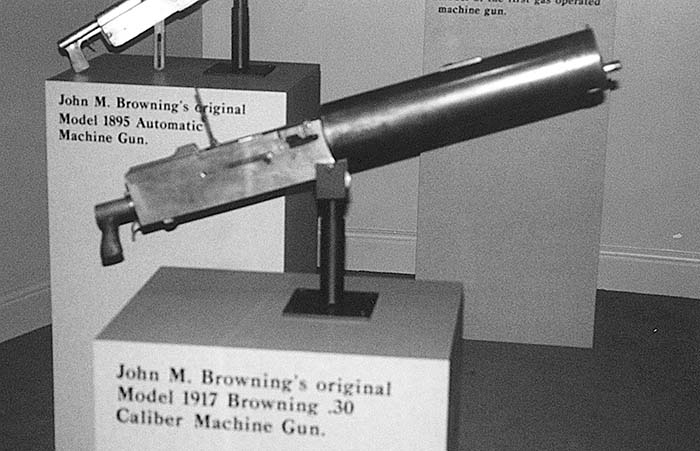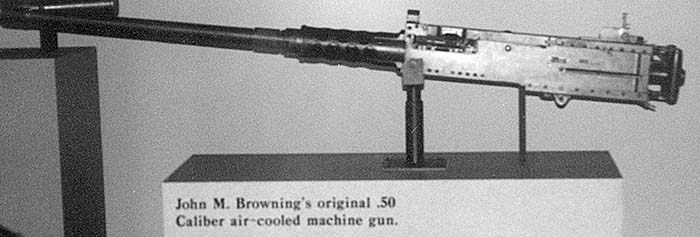Browning’s largest and last military invention, the 37mm aircraft cannon, is on exhibit in the form of the inventor’s original prototype.
Text & Photos by Robert M. Hausman
The story of this great small arms genius, whose inventions armed the forces of the United States during two world wars and beyond to the present day, is told by this institution. The story has its beginnings in the year of 1855 within the small settlement of Ogden in Utah Territory. John Moses Browning was one of twenty-two children born to polygamous Mormon, Jonathan Browning, himself a pioneering gunmaker who manufactured many of the guns and implements used in Brigham Young’s trek West.
Four sons of Jonathan, including John M., eventually formed a partnership and from their crude gunshop in the wilderness came gun designs which revolutionized the field of arms for more than half a century. Browning is credited with being the inventor of the automatic rifle, pistol, and shotgun as well as the machine gun. He registered 128 patents on more than eighty separate and distinct firearms.

Among the forty-four guns Browning sold to Winchester were the Model 85 single shot; the Models 86, 92, 94 and 95 lever-action repeating rifles; the Models 87, 93 and 97 repeating shotguns; the Model 90 .22-caliber pump-action repeating rifle; and the Model 1900 bolt-action .22. Browning’s Remington guns included the automatic shotgun, the Model 11, later the Sportsman; the Models 8 and 81 auto-loading center-fire rifles; the Models 24 and 241 .22 caliber auto-loading rifles; and the Model 17, a 20-gauge pump shotgun. The Government Model 1911 .45 auto. The list includes many arms produced by Fabrique Nationale and the Browning Arms Co. (formed a year after the gun inventor’s death), such as the .25 caliber pocket pistol, the Automatic-5 and Superposed shotguns.
The First Arm
Browning got his start by working in his father’s gunsmith shop. One day in early 1878, a man brought in a rifle for repair that was remarkably complicated. Browning, after studying how the rifle was put together, declared, “I could make a better gun than that myself.” His aging father replied,” I know you could, John Moses. And I wish you’d get at it. I’d like to live to see you do it.” Thus began Browning’s small arms design career at the age of 23.
It took him a little more than a year, but Browning received a patent for his first design, a single shot rifle. It was later used as the basis of his first gun designed for Winchester, the Model 1885. Browning and his brothers turned out as many single shot rifles as their crude shop could produce, selling them to local sportsmen and the market hunters prevalent in those days before game conservation.

In 1883, Andrew McAusland, a salesman for the Winchester Repeating Arms
Company, in the course of his travels came upon a single-shot rifle he had never seen before. Stamped on the barrel were the words: “Browning Bros. Ogden, Utah U.S.A.” McAusland bought the rifle and sent it to the Winchester factory, with a letter stating he hoped the management would find the arm sufficiently interesting to justify the fifteen dollars he had paid for it.
Winchester Alliance
It was found so interesting that, within a week, T.G. Bennett, Winchester’s vice president and general manager, was on his way to Ogden, authorized by his board of directors to buy the rifle. The Winchester product line at the time was successful with repeating designs, but not with single shots. Bennett realized the Browning gun could be adapted to handle virtually any cartridge, and he wanted to buy the design before one of his competitors did so. Within a few years, Winchester would become the largest producer of sporting arms in the U.S., and almost all of the Winchester arms would be Browning inventions.
While the lever action system was used as the action of choice for repeating shotguns in the latter part of the nineteenth century, Browning had recommended the pump action to Winchester, although Winchester was slow to put Browning’s pump action design into use. Finally, Winchester did put a pump action into production. First called the Model 93, after a few changes, notably a simple takedown system, it became the famous Model 97, which stayed in the line until 1957. The gun was known for its simple, rugged construction.

During World War One, a large number of Browning-designed Winchester Model 97’s were used as trench guns. A group of American soldiers, with prior experience in trap shooting, would be equipped with Model 97’s and stationed where they could fire at enemy hand grenades in midair to deflect them from falling into American trenches. The shotguns were also found especially effective on advancing enemy units. The shotgunners would hold their fire until the Germans would advance within range and then open up. Discharging nine .34 caliber buck shot pellets per shell, with six shells per gun, the bodies of enemy soldiers were said to have piled up one on top of another.
Birth of the Machine Gun
The invention of the gas-operated machine gun owed its existence to an ordinary event (to all but Browning) occurring in the fall of 1889. Just 34 years old at the time, Browning was attending the weekly shoot of the Ogden Rifle Club with his brothers. As Browning watched his friend Will Wright firing a rifle, a clump of weeds in front of Wright bent with the muzzle blast. All of the shooters, including Browning, had seen foliage bend from muzzle blast before, but this time, at least for Browning, it was different.
For this time, Browning saw utilizable energy (from the rifle being fired) going to waste. Immediately thinking about ways of putting that energy to good use, he rounded up his brothers and headed back to his workshop. On the way, Browning remarked how he realized the escaping cartridge gases could be harnessed by a firearm mechanism to operate some of its parts.

“Why, it might even be possible to make a fully automatic gun,” he said. “One that would keep firing as long as you had ammunition.”
When the reached the shop, a lever-action rifle chambered to fire the .44/40 black powder cartridge was laid on its side and wired to a wooden board. A hole slightly larger than .44 caliber was drilled into a foot length of two-by-four and the board was placed on the floor about a quarter inch from the rifle’s muzzle, with the hole lined up with the bore.
“What happens to that block of wood is what we want to see,” Browning explained. Taking a length of wire with a hook bent into the end, he prepared to pull the trigger. “That block will go hell-winding,” he predicted as he yanked the wire. It did and Browning immediately began to plan out the design of his first machine gun.
The next day, using the same lever-action rifle, they cut off part of the lever and lengthened and strengthened the trigger. Near the muzzle, a band was fitted with a descending arm. At the lower end of the arm, another piece of metal was hinged that stretched back up to the muzzle, where it widened into a circular disk, slightly larger in diameter than the barrel. In this disk, a hole was drilled slightly larger than .44 caliber.
In operation, as the bullet passed through the hole in the disk, the gas pushed the disk forward, and an attached spring pulled it back. The rod attached to the disk was attached to the modified lever, and the to-and-fro movement of the disk actuated the movement of the operating parts of the rifle. The gun was being fired by 4 o’ clock that afternoon. The 8-pound gun’s cyclic rate of fire was about 960 rounds per minute.
Many more models were built before Browning made his first patent application for the principle of gas operation in January 1900. And many more prototypes were built after it. In November 1890, Browning offered his machine gun design to Colt’s Manufacturing as they were the maker of the crank-operated Gatling Gun. Noting he had built two models, Browning wrote to Colt that the first, fired “a .44 Winchester Center fire cartridge at the rate of 16 times per second,” while the other, “shoots the .45 Government charge about six times per second and with the mount weighs 40 pounds. It is entirely automatic and can be made as cheaply as a common sporting rifle.” Though Browning didn’t know it, the Gatling Gun weighed a massive 90 pounds.
Colt’s reply was favorable, so a few weeks later Browning and his brother Matt arrived in Hartford, one carrying the machine gun, the other the mount wrapped in a canvas cover. Demonstrating the gun for Colt’s president, John Hall, Browning fired four fifty-round belts of .45-70 cartridges without a hitch. The connection between Colt and Browning that developed that day lasted for seventy years.
Browning’s machine gun, after some further refinements, became known as the Colt Model 1895 and was the first machine gun purchased by the U.S. government. The gun was used in naval action during the Spanish-American War, by U.S. marines in Peking during the Boxer rebellion, and was used in France during World War One.
The gas-operated Model 1895 Automatic Machine Gun, as manufactured by Colt, had a hole drilled through the barrel near the muzzle which activated a piston that worked the gun’s action through a swinging lever. The unusual movement of the piston, which swung in a half arc beneath the barrel, gave the gun a nickname-”The Potato Digger.”

Feeding from a fabric belt, and chambered in .30/40 Krag and 6mm Lee, the Model 1895 (as manufactured by Colt) had a rate of fire of 400 rounds per minute. Air cooled, and equipped with a 21-1/2 inch heavy barrel, total production figures during World War One alone comprised some 1,500 units.
In August 1891, Browning filed two additional patent claims. One, instead of using the disk at the muzzle, used a small turbine. The turbine allowed the bullet to pass through freely while tapping the energy of the expanding gases following the projectile to power a system of gears operating the mechanism. The other patent covered the entire mechanism of his first fully-automatic machine gun.
In October 1896, Browning filed three patent applications having tremendous influence on the design of future automatic firearms. These were for blowback operation, the locked-recoil system with a turning lock and the locked-recoil system with a pivoting lock.
MG Profiles
Browning’s Model 1917 .30 caliber heavy machine gun in its air-cooled version (another version was water-cooled), was the first machine gun to be successfully attached to pursuit planes allowing the pilot to simultaneously guide the plane and aim the gun. To allow this remarkable feat, the firing of the gun was synchronized with the motor of the plane so the fired bullets passed through the revolving propeller without hitting the blades.
Chambered for the .30/06 cartridge, the Model 1917 fed from a link belt and fired at the cyclic rate of 600 rounds-per-minute (in the water-cooled version) and 700 rpm in the air-cooled variation. Between its official adoption in 1917 and the Armistice bringing an end to the war the following year, about 43,000 were produced. Over a million units of the World War Two version of this gun (designated as the .30M2) were built.
Browning’s work in developing the machine gun was so successful, that through World War’s One and Two, as well as the Korean conflict, all the machine guns used by U.S. forces were Brownings.
In February 1917, less than two months before America entered World War One, Browning gave a demonstration to officials in Washington, D.C. of his then latest model, the B.A.R. (Browning Automatic Rifle). While heretofore machine guns had been cumbersome devices, whose heaviness required them to be fired from a mount, the B.A.R. provided the capability of “walking fire.” It could be carried by individual soldiers and fired from the shoulder or the hip, in the semi-auto or full-auto modes emptying its 20- round magazine in 2 1/2 seconds.

The B.A.R. was so simply constructed that its 70 parts could be disassembled and reassembled in under a minute. As a result of this demonstration, the U.S. government adopted the arm. (This approval followed, by several years, the adoption in 1911 of the Colt .45 caliber automatic pistol, invented by Browning in 1905, as the official U.S. military sidearm).
While best known as the B.A.R., the arm is also designated as the Browning Light machine rifle Model 1917, the Light Browning, the Colt Automatic Machine Rifle, and the Fusil Mitrailleur Browning. The version of the B.A.R. as produced by Colt is an air-cooled, gas-actuated machine rifle with a detachable box magazine. A lever on the receiver allows fully automatic or semi-auto firing. The full-auto rate is 480 rounds-per-minute which empties the 20-round magazine in 2-1/2 seconds.
When the fire control lever is in its forward position, marked with the letter “F”, the rifle will fire one shot with each pull of the trigger. When the lever is in the vertical position, marked with the letter “A”, the rifle will fire in the full-auto mode. In its most rearward position, marked with the letter “S”, the rifle is on safe. Equipped with a 24-inch round barrel, the piece weighs 17-pounds, 6 ounces with a full magazine.
During World War One, about 52,000 B.A.R.’s were manufactured by Colt, Marlin-Rockwell and Winchester. After the war, Fabrique Nationale in Belgium began production in 1920. The rifle has been manufactured in the chamberings of 6.5mm, 7mm, 7.9mm and 7.62mm, in addition to .30/06. In 1922, the U.S. Army brought out a “Cavalry Model” of the B.A.R. and in 1933 Colt produced the “Colt Monitor” version for police and bank guard use. Approximately 177,000 B.A.R.’s were produced in the U.S. during World War Two.
In contrast to earlier versions, B.A.R.’s produced during World War Two are slightly heavier and are equipped with a flash hider and bipod These were made with a stock without a pistol grip. A decelerating device permits either high (550 rounds per minute) or low (350 rpm) cyclic rates of fire. While no provision was made for semi-auto fire, when set at the low rate of fire, single shots can be fired with practice.
The Big Fifty
Browning followed up with design of his famous .30 caliber M2 machine gun, and at the request of the government for a machine gun capable of defeating the heavy armor on German war vehicles, the .50 caliber machine gun. The .50 caliber M2 differed from the earlier .30 caliber model mainly through the use of an oil buffer that absorbed the excessive energy of recoil to reduce stress on the parts. The buffer also provided a means of controlling the rate of fire.
While produced too late for World War One, the Browning .50 caliber saw extensive use during World War Two. The Japanese, using captured M2’s as examples, used the design as a model for nearly all their wartime cannon development. The Germans were equally impressed. In a captured document from Field Marshal Goering congratulating General Rommel on the latter’s capture of thousands of Browning .50 calibers during the African campaign, Goering noted, “If the German Air Force had the Browning .50 caliber, the Battle of Britain would have turned out differently.”
Aircraft Cannon
Browning began developing aircraft cannon (his last military invention) in early 1921, and within three months of his start of the project, was successfully firing a prototype model in the hills outside Ogden. The cannon was demonstrated to U.S. Army officials at Aberdeen Proving Ground later in the year. Firing a 1-pound projectile at a muzzle velocity of 1,400 feet-per-second, the cannon’s cyclic rate of fire was 150 rounds-per-minute. Two additional models were developed, each firing heavier projectiles at 2,000 and 3,000 fps respectively. While not used extensively by U.S. forces during World War Two, the cannon was used extensively by the Russians as their primary aerial cannon against German tanks.
The competition during the government cannon testing trails had been the Baldwin gun. While beautifully made, it could not fire more than 8-rounds without jamming or breaking down. With the acceptance of the 37mm gun, Browning had achieved what no one else had, every one of his guns submitted for government trials had won over all competition.
Operation of the Browning 37mm Aircraft Cannon is by the long-recoil principle. Both recoil and counter-recoil are controlled by a hydro-spring buffing mechanism. The breechblock is of the vertical, sliding wedge variety. When the projectile is fired, the barrel, breech-block and locking frame, while all locked together, move backward ten inches due to the forces of recoil before the breechblock cams downward. Consequently, the hammer is cocked, the empty case ejected, a new shell loaded and the mechanism is again locked and ready for subsequent firing.
Last Days
In the summer of 1926 at home in Ogden, shortly before Browning made his last trip to the Fabrique Nationale factory in Belgium, perhaps sensing his mortality, he was heard to remark, “You know, the time and the place for a gunmaker just got together on this corner. And I happened along.” He died that fall of heart failure within the F.N. plant, while at work on his last sporting design, the Superposed shotgun.
The English translation of a bronze plaque hanging in the Fabrique Nationale d’Armes de Guerne factory in Liege, Belgium, reads: “To the memory of John M. Browning 1855-1926. This is the place where Browning traveled to from Ogden to have his first auto- loading pistol manufactured and where, on the twenty-sixth of November, 1926, while he has busily engaged at work, death overtook the greatest firearms inventor the world has ever known.”
Museum Exhibits
The Browning Firearms Museum opened in October 1978 and contains over 90 original prototypes or production models of Browning-designed firearms. Display models include the original BAR (Browning Automatic Rifle) mainstay of the U.S. Army for 80 years, as well as the machine guns that protected U.S. vehicles and aircraft. Displays also includes the work of Jonathan, Val A., and Bruce B. Browning (father, son and grandson) of John M. The Browning Arms Co. is located nearby in the town of Morgan.
Included among the collection are a number of models never commercially produced, such as a hammerless .45 ACP pistol, and six different .38 ACP-chambered auto pistols made for Colt prior to the production of the seventh model which became known as the Colt Model 1900, the first auto pistol to be manufactured commercially in the U.S.
The guns in the museum are displayed in a manner providing all around visibility. The displays are arranged in time lines to lead the visitor through the chronology of Browning’s inventions.
The Browning Firearms Museum is contained within the Ogden Union Station museum complex. The building, once a bustling train station, now makes for a good balanced day-trip for the entire family. The Utah State Railroad Museum within the building, is dedicated to preserving the rich railroad heritage of Utah from the original joining of the transcontinental railroad in 1869. The Eccles Rail Center focuses on the locomotives designed to pull large trains through steep western terrain. The most powerful locomotive built is displayed: a gas turbine designated the Big Blow, which was rated at over twice the horsepower of a typical modern locomotive.
The Wattis-Dumke Model Railroad Museum shows realistic models of the early transcontinental railroads which conquered major obstacles, such as the Great Salt Lake, and the Wasatch and Sierra Mountains. The Browning/Kimball Car Museum shows some of the most innovative and elegant examples of automotive design ranging from a single cylinder 1901 Oldsmobile to a 16-cylinder three-ton Cadillac. A Natural History Museum showcases records of dinosaur and aquatic life-forms, as well as fossilized wood and plant material. The Myra Powell Gallery displays art from local and world-renowned artists, as well as traveling exhibits from national collections. A gift shop offers a variety o memorabilia, books, videos and souvenirs related to the museums. A volunteer group of “conductors” share their experience with visitors as they tour the museums.
Getting there:
The Browning Firearms Museum is located at 25th Street and Wall Avenue, Ogden, Utah 84401.
From Salt Lake City, take I-15 or I-84 northbound to exit 344A Make a right on Wall Avenue and follow to the museum which is near the center of town on the left. The Browning museum is open from 10 am to 5 pm Monday through Saturday. Call ahead for summer hours. The museum can be reached at (801) 629-8444 for more information.
| This article first appeared in Small Arms Review V3N8 (May 2000) |











